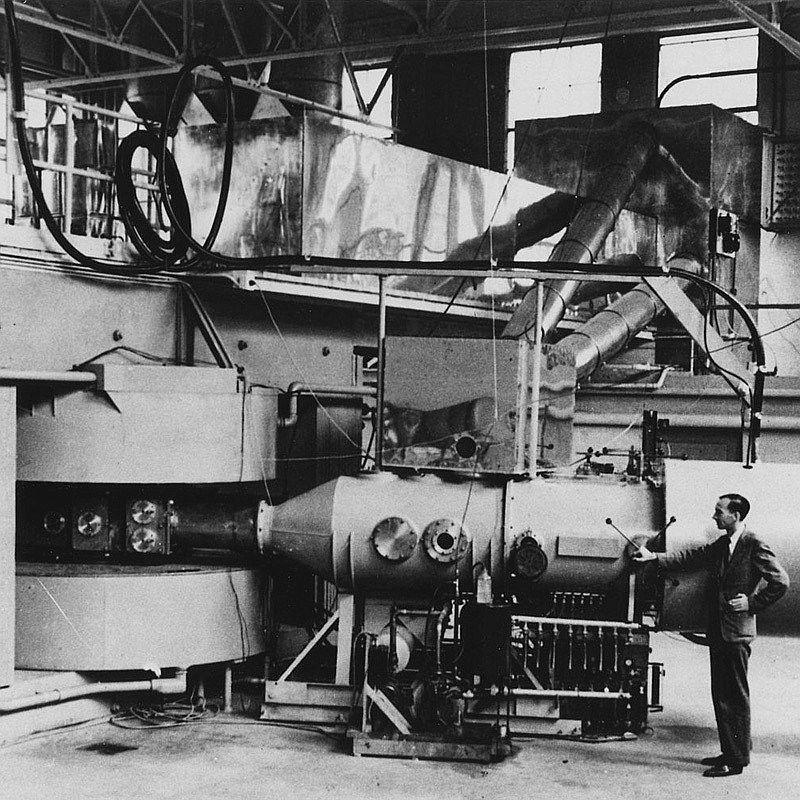Berkelium
97
Bk
Gruppe
I/T
Periode
7
Blokk
f
Protoner
Elektroner
Nøytroner
97
97
150
Generelle egenskaper
Atomnummer
97
Atomvekt
[247]
Massetall
247
Kategori
Aktinoider
Farge
I/T
Radioaktiv
Ja
Named after Berkeley, California, the city of its discovery
Krystallstruktur
Enkelt heksagonal
Historie
Berkelium was discovered by Glenn T. Seaborg, Albert Ghiorso and Stanley G. Thompson in 1949 at the University of California, Berkeley.
It was produced by the bombardment of americium with alpha particles.
Berkelium was isolated in greater quantities for the first time by Burris Cunningham and Stanley Thompson in 1958.
It was produced by the bombardment of americium with alpha particles.
Berkelium was isolated in greater quantities for the first time by Burris Cunningham and Stanley Thompson in 1958.
Elektroner per energinivå
2, 8, 18, 32, 27, 8, 2
Elektronkonfigurasjon
[Rn] 5f9 7s2
Just over one gram of berkelium has been produced in the United States since 1967
Fysikalske egenskaper
Fase
Fast stoff
Tetthet
14,78 g/cm3
Smeltepunkt
1259,15 K | 986 °C | 1806,8 °F
Kokepunkt
3173,15 K | 2900 °C | 5252 °F
Smeltevarme
I/T kJ/mol
Fordampningsvarme
I/T kJ/mol
Spesifikk varmekapasitet
- J/g·K
Forekomst i jordskorpa
I/T
Forekomst i universet
I/T

Bildekreditter: Wikimedia Commons (Department of Energy - Office of Public Affairs)
The 60-inch cyclotron at the Lawrence Radiation Laboratory, University of California, Berkeley
CAS-nummer
7440-40-6
PubChem Sammensatt identifikasjonsnummer (CID-nummer)
23971
Atomegenskaper
Atomradius
170 pm
Kovalent radius
-
Elektronegativitet
1,3 (Pauling-skalaen)
Ioniseringsenergi
6,1979 eV
Molart volum
16,7 cm3/mol
Termisk ledningsevne
0,1 W/cm·K
Oksidasjonstilstander
3, 4
Bruksområder
Berkelium is mainly used for scientific research purposes.
Berkelium-249 is a common target nuclide to prepare still heavier transuranic elements and transactinides, such as lawrencium, rutherfordium and bohrium.
It is also useful as a source of the isotope californium-249.
Berkelium-249 is a common target nuclide to prepare still heavier transuranic elements and transactinides, such as lawrencium, rutherfordium and bohrium.
It is also useful as a source of the isotope californium-249.
Berkelium is harmful due to its radioactivity
Isotoper
Stabile isotoper
-Ustabile isotoper
233Bk, 235Bk, 236Bk, 237Bk, 238Bk, 239Bk, 240Bk, 241Bk, 242Bk, 243Bk, 244Bk, 245Bk, 246Bk, 247Bk, 248Bk, 249Bk, 250Bk, 251Bk, 252Bk, 253Bk, 254Bk